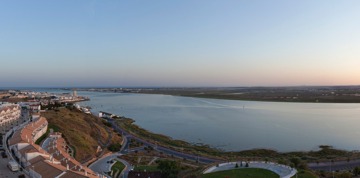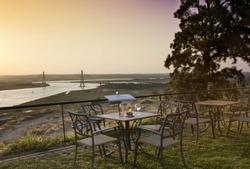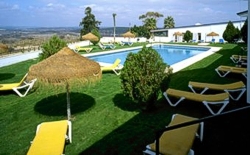
AYAMONTE, Andalusia, SpainMost of the narrow streets in the centre of Ayamonte are pedestrianized which always makes exploring on a foot a much more pleasant experience. Being right on the border, many of the plazas have a similar look to those you would find in Portugal, and the most elegant is the Plaza de la Laguna in the historic quarter. There are many ancient buildings to admire in the old quarter such as the Convent de San Francisco with its very beautiful Mudejar ceiling. The town hall, La Casa Grande, was built in 1745 and situated in the Plaza de Rosario. The facade is made from oyster stone, and in the centre of this fine building is an attractive courtyard surrounded by marble pillars. Inside there is also a library, theatre, and art gallery exhibiting works by local artists. The oldest church in the quarter is the 15th century Iglesia de San Salvador and if you climb its tower you can lovely views of Portugal in the distance. As mentioned earlier, Ayamonte has some great beaches. The Playa Isla Canela is only a 5 minute drive from the centre and can be reached by a causeway across the salt marshes and wildlife reserve. There is also a bike path that runs all the way to the beach so you can either roller blade or hire bikes if you do not have your own transportation. The beach stretches for just over 5km and lined with beach bars. There are opportunities to go windsurfing or kitesurfing, and should you prefer to just chill out for a few hours you can hire hammocks and umbrellas. The Playa Punta del Moral is a much smaller beach with beautiful golden sand and calm waters. Because it has a very high standard of cleanliness and excellent facilities, it has been awarded Blue Flag status by the European Union.
Located along the road that leads to the Isla Canela Marina is the Torre Isla Canela, which was commissioned in the late 16th century to protect the coast from attack by pirates. An interesting discovery was made while they were restoring the tower. Normally these sorts of towers had roofs that sloped inwards so any rainwater could be drained off and used by the guards. However, in this case the roof sloped outwards, and it was only by opening up a section of the floor that they discovered a hidden well.
Ayamonte has some fascinating museums to visit and one of them is the Eco-Museum Molino el Pintado. It was once the most important tidal mill along this stretch of coast and produced flour which was sold around the world. There were six different milling stones that were all operated by a single person, and at the front of the mill were the living quarters of the millerís family. The museum not only explains the history of the mill but also how the marshlands were formed and how they provided a way of living for the locals from harvesting salt to fishing. It is actually strongly recommended you visit the salt flats as you will get to see the fascinating methods used over the centuries to harvest salt. The water that flowed in from the sea was normally about 5C and as it journeyed through the marsh it was then channelled into various heating pools. By the time the water reaches the evaporation pools the temperature has increased to 27C and this is when salt crystals begin to form, producing five different types of salt. Like most of Spain, Ayamonte hosts several entertaining festivities throughout the year. Their Carnival in February is very similar to the one in Rio de Janeiro with lots of colourful costumes, parades, and music competitions. It ends by setting fire to the Entierro de la Sardina which is a giant effigy of a sardine and represents Judas, the disciple who betrayed Jesus.
In September is the Angustias Festival that takes place over six days. The festival begins at the docks with a live band arriving by ferry from Portugal. The crowd then follow the band as they march into the Plaza de la Laguna, and like all Spanish festivals there are lots of parties, plenty of food, bullfighting, live music, and fireworks. There is a very interesting story behind the sculpture of this patron, Nuestra Senora de las Angustias. In 1756 local fishermen fishing in Portuguese waters almost capsized their boat as they pulled up a treasure chest in their net instead of fish. The Portuguese coastal authorities were alerted of the fishmenís catch and insisted they hand over the chest, but they refused and instead invited them to witness the opening on their return to Ayamonte. To their surprise however the chest contained a sculpture rather than jewels or gold.
A rather long debate followed over who had rights to the sculpture and in the end the Portuguese won their case. However, each time the handover was meant to take place a huge storm would blow in making it impossible to make the exchange. Three times they tried and three times they failed, until eventually the Portuguese authorities gave in to the pleas of the people of Ayamonte and allowed the sculpture to remain in Spain.
Being right on the border it is also very easy to make a day trip to the Algarve which can be reached either by ferry and bus. This extra dimension to your holiday makes Ayamonte all the more appealing as it can also provide excellent accommodation at the Parador Hotel Ayamonte. This four star hotel overlooks the river and flood plains, has a gastrobar, and seasonal swimming pool which is always welcome during the hot summer months.
|

